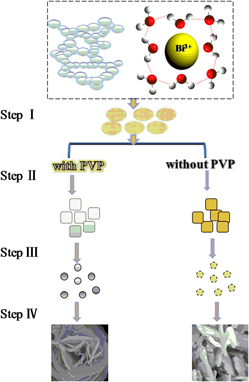Crossref Citations
This article has been cited by the following publications. This list is generated based on data provided by
Crossref.
Wei, Wei
Yue, Xuejie
Cui, Henglv
Lü, Xiaomeng
and
Xie, Jimin
2013.
Hydrothermal synthesis and properties of BiVO4 photocatalysts.
Journal of Materials Research,
Vol. 28,
Issue. 24,
p.
3408.
Zong, S.
Wei, W.
Cui, H.
Jiang, Z.
Lü, X.
Zhang, M.
and
Xie, J.
2015.
A novel synthesis of P/BiPO4nanocomposites with enhanced visible-light photocatalysis.
Materials Research Innovations,
Vol. 19,
Issue. 5,
p.
361.
Wei, Wei
Gao, Jinrong
Jiang, Zhifeng
Lü, Xiaomeng
and
Xie, Jimin
2015.
Transforming MoO3 macrorods into bismuth molybdate nanoplates via the surfactant-assisted hydrothermal method.
Ceramics International,
Vol. 41,
Issue. 9,
p.
11471.
Zhu, Ya.Nan
Mu, Jing.Jing
Zheng, Gan.Hong
Dai, Zhen.Xiang
Zhang, Ling.Yun
Ma, Yong.Qin
and
Zhang, Di.Wei.
2016.
Morphology, photocatalytic and photoelectric properties of Bi2MoO6 tuned by preparation method, solvent, and surfactant.
Ceramics International,
Vol. 42,
Issue. 15,
p.
17347.
Jia, Kun-Le
Qu, Jin
Hao, Shu-Meng
An, Fei
Jing, Ya-Qiong
and
Yu, Zhong-Zhen
2017.
One-pot synthesis of bismuth silicate heterostructures with tunable morphology and excellent visible light photodegradation performances.
Journal of Colloid and Interface Science,
Vol. 506,
Issue. ,
p.
255.
Wu, Yuanting
Li, Menglong
Yuan, Jun
Lu, Jian
Wu, Penghong
Liu, Changqing
and
Wang, Xiufeng
2018.
A facile Pechini method to synthesize novel Bi12SiO20–Bi2SiO5 heterostructure photocatalysts with enhanced visible light photocatalytic activity.
Journal of Materials Science: Materials in Electronics,
Vol. 29,
Issue. 6,
p.
4503.
Back, Michele
Trave, Enrico
Zaccariello, Gloria
Cristofori, Davide
Canton, Patrizia
Benedetti, Alvise
and
Riello, Pietro
2019.
Bi2SiO5@g-SiO2 upconverting nanoparticles: a bismuth-driven core–shell self-assembly mechanism.
Nanoscale,
Vol. 11,
Issue. 2,
p.
675.
Chen, Yu
Wang, Shan
Liu, Jie
Zhang, Yefei
Long, Yanju
Li, Lingxin
Zhang, Sifeng
Wang, Lulu
and
Jiang, Fengzhi
2019.
Self-assembly of efficient flower-like Bi2SiO5 photocatalyst through Pt modification.
Journal of Photochemistry and Photobiology A: Chemistry,
Vol. 382,
Issue. ,
p.
111920.
Wu, Yuanting
Lu, Jian
Li, Menglong
Yuan, Jun
Wu, Penghong
Chang, Xiaojing
Liu, Changqing
and
Wang, Xiufeng
2019.
Bismuth silicate photocatalysts with enhanced light harvesting efficiency by photonic crystal.
Journal of Alloys and Compounds,
Vol. 810,
Issue. ,
p.
151839.
Yu, Si-Yuan
Zhang, Ling
Zhu, Li-Bang
Gao, Yuan
Fan, Gao-Chao
Han, De-Man
Chen, Guangxu
and
Zhao, Wei-Wei
2019.
Bismuth-containing semiconductors for photoelectrochemical sensing and biosensing.
Coordination Chemistry Reviews,
Vol. 393,
Issue. ,
p.
9.
Arefieva, O. D.
Vasilyeva, M. S.
Lukiyanchuk, I. V.
Sedinkina, E. S.
Zemnukhova, L. A.
and
Pisartseva, A. I.
2021.
Preparation and Photocatalytic Properties of β-Bi2O3/Bi2SiO5 Heterostructures.
Russian Journal of Inorganic Chemistry,
Vol. 66,
Issue. 6,
p.
943.
Bermeshev, T. V.
Zhereb, V. P.
Tas-Ool, R. N.
Mazurova, E. V.
and
Metelitsa, S. I.
2021.
Phase separation in the Bi2O3-SiO2 system. Effect of cooling conditions on the phase composition and microstructure of solidification products.
Russian Chemical Bulletin,
Vol. 70,
Issue. 8,
p.
1462.
Arefieva, O.D.
Vasilyeva, M.S.
Zemnukhova, L.A.
Opra, D.P.
Nikolaeva, D.A.
Tkachev, V.V.
and
Shlyk, D.H.
2023.
Effect of silica source on photocatalytic properties of Bi2O3/Bi2SiO5 heterostructure.
Journal of Bioresources and Bioproducts,
Vol. 8,
Issue. 2,
p.
176.





